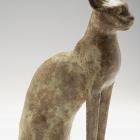The Cat goddess, bronze, Late Period (7th – 4th century), unknown origin (inv. n. E 0.9.40324)
In the vast and complex repertoire of egyptian gods, the cat, although identified with different goddesses, was especially linked to the goddess Bastet from the 10th century BC, whose cult was centred in the Delta, in Bubastis. The goddess, initially represented as a lioness-goddess, in cat form became a symbol of femininity and protected the family hearth. The statues and mummies of cats, often inserted into empty bronze statuettes, were donated to the goddess by her devotees to win her favours. With the introduction of lost-wax casting, from the New Kingdom (16th century BC) and in particular during the Late Period (7th to 4th century BC ), replacing the more ancient hammered sheet bronze work, we witness the beginnings of serial production of statuettes of Egyptian deities in their








